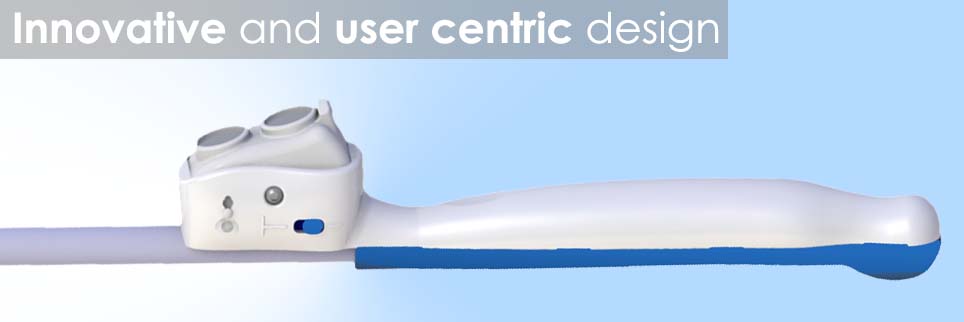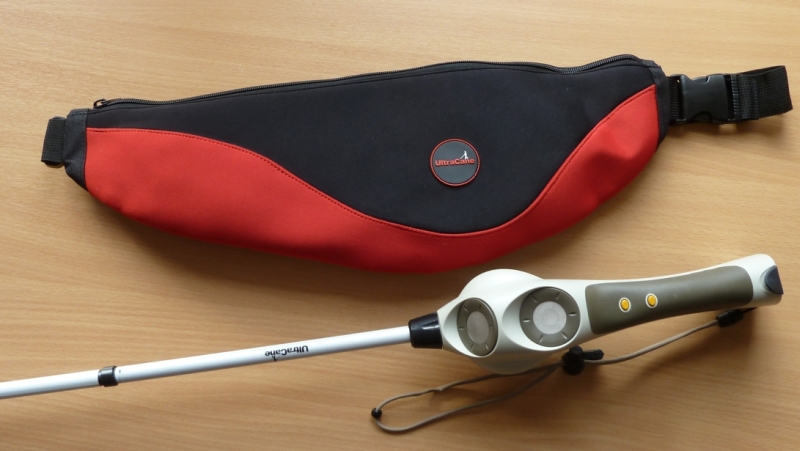Last week I wrote about Martina Caironi and prosthetic limbs. Today I want to sort of continue the theme by looking at technological aids for the blind or visually impaired. Many readers will have smartphones in their hands and smartmeters in their homes, but I would like to introduce you all to the world of smart-canes.
A cane offers a lot of information to a blind user, but it tends to concentrate on the floor or at best below knee level. Users can avoid objects that are attached to the floor, but overhanging tree branches and other free standing objects are much more difficult to detect. I would like to take a look at two possible solutions, one produced in India and relatively low cost, and the other produced in the UK and relatively high cost.
The Smartcane is the Indian solution, see the photo above. It costs about $50 US, and its designers say it is innovative and user centric. It detects obstacles using sonic waves and the presence of obstacles is conveyed through intuitive vibratory patterns. It is powered using a rechargeable Li–ion battery, and is seperate from the cane, so the user attaches the technology to their existing cane.
The Specs (as taken from the website):
Adjustable detection range: User can switch between long (3 metre) and short (1.8 metre) range mode depending on the usage scenarios such as outdoor, indoor or crowded places.
Ergonomic grip for comfortable holding and cane tapping: Can be held by different gripping styles, allowing users to use their natural cane holding and mobility techniques.
High detection sensitivity: The sensors can detect a 3 centimetre wide pipe from 3 metres distance, ensuring reliable detection of objects in the detection range.
Four intuitive and distinctive vibration patterns indicating obstacle distance.
Vibrations are uniformly produced on the entire grip: Non-localized vibration feedback allows user to conveniently grip the device.
Does not interfere with the auditory environment surrounding the user Vibrations allow discreet continuous use without making the user conscious or creating annoyance to others
Adjustable sensor orientation: Allows people of different heights and with different cane holding styles to direct the sensors appropriately.
In-built rechargeable battery with a long battery back-up: Removing of batteries for charging is not required.
Fully accessible user interface: Simple and distinguishable beeps to convey the battery charge status, low battery warning and charging status.
Failure detection of key components: Users informed immediately on failure of sensors and/ or vibrator through special alarm signals.
Detects fast approaching objects in the detection range: Especially helpful in detection of reversing vehicles.
Easy attachment / detachment from a white cane: Allows for compatible white cane replacement by the user himself.
Multiple colour options: Available in two non- flashy and elegant colours
Robust design: Can withstand accidental fall
Splash proof: Prevents damage during light rain
Conforms to international quality standards
Sounds like a deal to me!
In the UK users can order the above or splash out on another product called Ultracane. The Ultracane works in a similar way to the Smartcane, but it is a single piece of equipment. You order the cane by length. It boasts more or less the same technical specs as the above, but the batteries are interchangeable (so it does not look as if they are rechargeable in situ), it has a strap to aid in holding it, it is foldable and has a replaceable tip. It works over 4 mtrs in front (further than the Smartcane) and 1.6 mtrs in an upward direction. It also has a twin range, choice of tip, is shower-proof, and is available in any colour you like as long as it’s white.
It costs somewhere in the region of $900 in the UK, has a 12 month guarantee and there is a service centre in case of accidents.
I am sure that much of the difference in price is due to development expenses, the Ultracane was very much on its own when it was developed, and has been on the market for several years. The website hosts many happy testimonials. I am pleased to see the development in India though, as it may give many in the developing world access to the kinds of aids that we in Europe have. Ultracane has also developed the Ultrabike, giving the partially sighted the chance to take to the bike paths in safety.
Check out the websites linked above for more information.

